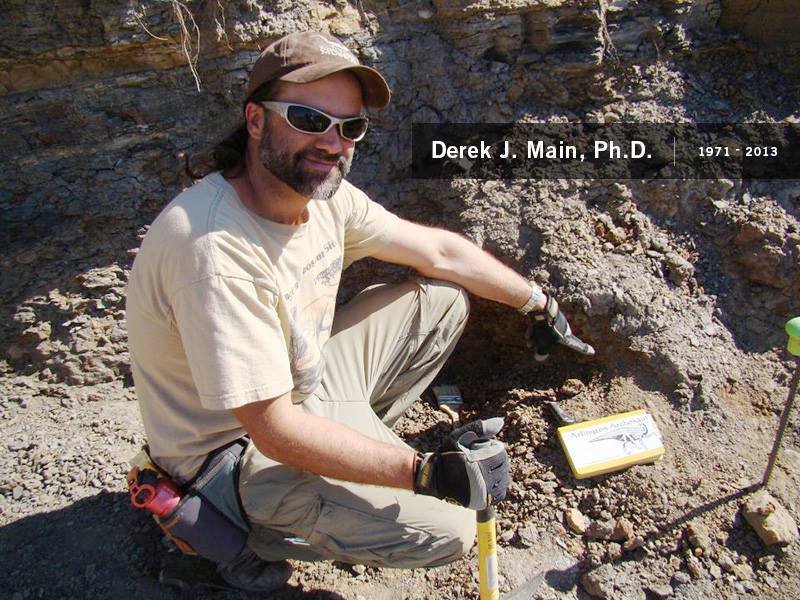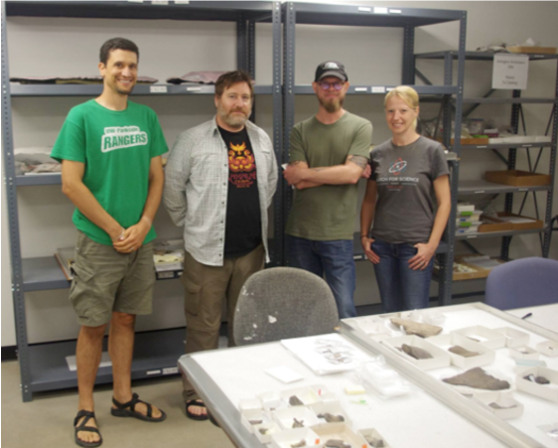 Late Cretaceous Turtles
Late Cretaceous Turtles
A recent paper published in Palaeontologia Electronica highlights a treasure trove discovery of fossil turtles from the Arlington Archosaur Site (AAS) Woodbine Formation in Texas, including a new species “Trinitechelys” maini. The AAS is known for its archosaur fossils. Archosaurs are vertebrates that have a single opening in their skull on the left and right side. Crocodiles and birds are modern archosaur examples, while all dinosaurs and pterosaurs are extinct members of the group.
 Image of the late Dr. Derek Main, the founding paleontologist of the AAS, after whom the new species "Trinitichelys" maini was named.
Image of the late Dr. Derek Main, the founding paleontologist of the AAS, after whom the new species "Trinitichelys" maini was named.
The Woodbine Fm. dates back to the Cenomanian Age, representing the onset of the Late Cretaceous Period (93-99 million years ago). This was when dinosaurs really began to diversify and evolve into forms we all recognize like Triceratops and T. rex. North America was separated in half by a large epicontinental seaway, where this portion of Texas involved a large delta plain that drained freshwater runoff from the eastern highlands.
Turtle researcher and lead author on this article, Brent Adrian adds “The freshwater input was considerable from northern highlands, and each turtle discovered had a particular degree of tolerance to brackish water. Sophisticated salt processing mechanisms such as salt glands hadn’t evolved yet in turtles, so clues to the water quality can help us get a better handle on associated animals and plants that were collected.”
The delta plain was a lush swampy area where top crocodyliform predators like Deltasuchus and Scolomastax ate just about anything that crossed their paths, including dinosaurs and turtles. Predation pressures and diverse freshwater environments “kept freshwater turtles from venturing far into the ocean” says Mr. Adrian.
“The turtles in this study include a combination of endemic (native) North American species, and members of Asian and Gondwanan lineages” Adrian continues. Gondwana was an ancient large continent that included almost every modern continent except for North America and Asia. “The two immigrants from Asia and Africa were smaller and more adapted to brackish water, so they were able to exploit smaller bodies of water” says Adrian. Further study of skull features with comparison to living turtle relatives will provide the researchers clues as to what the turtles ate and how they moved around.
Additionally, these researchers conducted some phylogenetic analyses to understand how these turtle species fit within the umbrella of turtle evolution. “Since there is no organic material in fully fossilized specimens and therefore no remaining DNA, phylogenetic analyses in paleontology are typically based on bone morphology” explains Adrian. Basically, they compare the shapes and sizes of the same bones between turtle species. “Our newly described baenid turtle “Trinitechelys” maini is clearly different from known taxa where these analyses allowed us to place the turtle more precisely within the baenid tree.”
 Carapace of the new species “Trinitichelys” maini.
Carapace of the new species “Trinitichelys” maini.
This type of research helps determine new species and also how certain features may have helped these turtles become so successful in specific environments.
“This study fills a 20 million year gap in the vertebrate fossil record in the region, so it gives us a glimpse at the transitional forms that lived on the Appalachian (eastern) side of the Western Interior Seaway that separated the western and eastern subcontinents of North America at the time” states Adrian.
Being a Florida native, Adrian was able to volunteer with sea turtle rehabilitation and release programs at the Loggerhead Marinelife Center as a teenager. Then at Midwestern University he was introduced to fossil turtle material from the AAS site, where he could combine his passions of turtles and paleontology into a research career.
“Turtles have persisted for around 250 million years, and they appear in the fossil record nearly everywhere, but relatively few people study them. Turtles are often understudied compared with dinosaurs, so there is still much to learn from them, especially from the insights they provide about ancient environments.” says Adrian.
There is much left to learn from the remains found at the AAS site, however even these four turtle species provide insight into how turtles evolved during the Cretaceous amid the time of the dinosaurs.

You can access the original article here!

